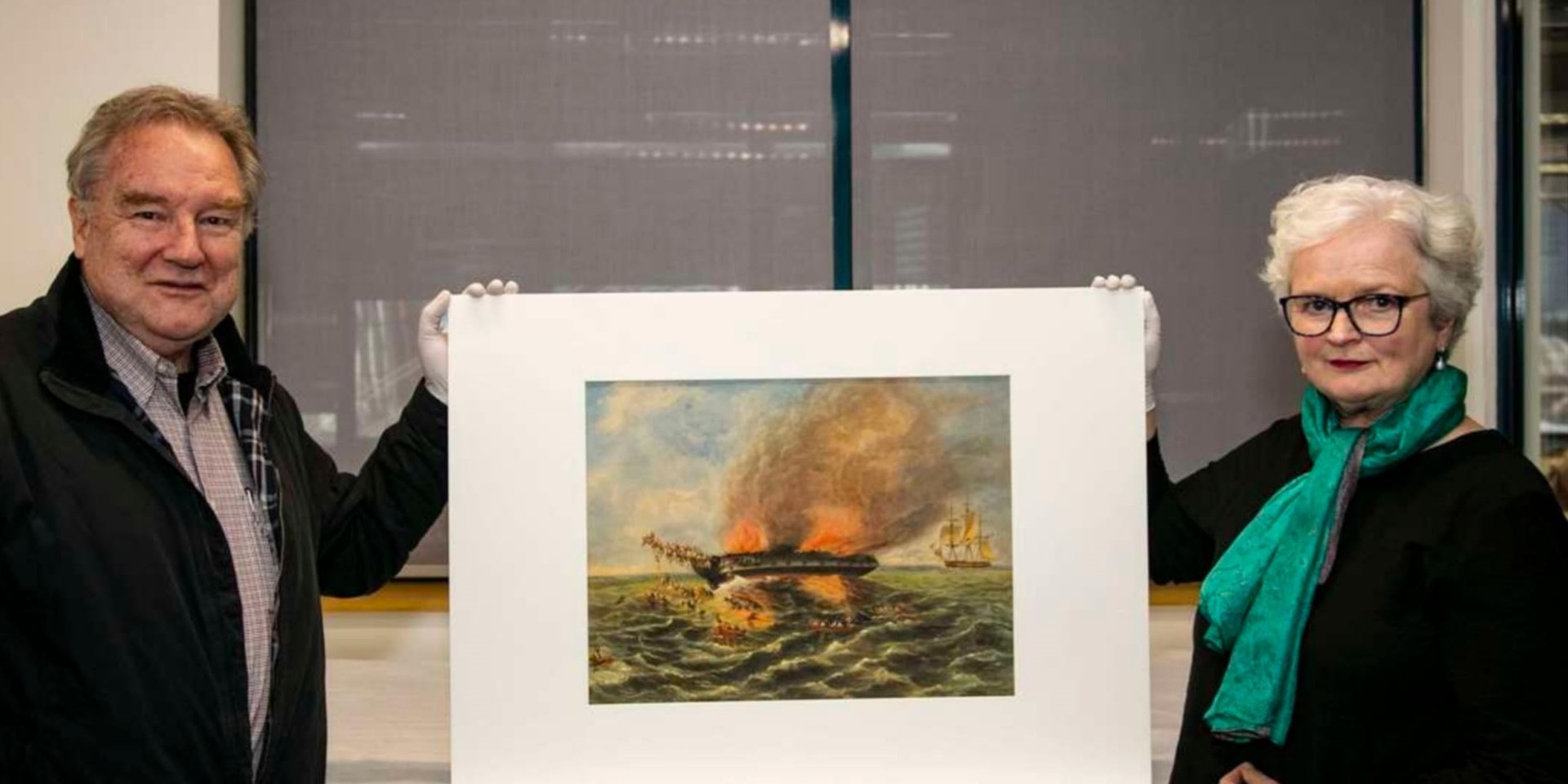

Samuel Elyard, Burning of the Barque India, c 1841. Watercolour on paper, 41.7 x 55 cm. ANMM Collection 00004246.
One of the museum’s most-requested paintings for public viewing is a dramatic watercolour by Sydney landscape artist Samuel Elyard (1817–1910) titled Burning of the Barque India (c 1841). Recently we arranged a viewing for cousins Catherine Bell and John Grant. Their great-great-grandparents John Scott Grant and Ann Grant (née Kilpatrick) were survivors of the ill-fated migrant ship, which caught fire and sank in the South Atlantic Ocean on 19 July 1841.

An advertisement for India in the Greenock Advertiser, 24 May 1841.
John Scott Grant (1821–1879) and Ann Grant (1825–1903) spent their early years in and around Edinburgh, Scotland. John was the son of a flax dresser and was a blacksmith by trade, while Ann was the daughter of a miller on the Water of Leith. In June 1841, just three weeks after their wedding at New Greyfriars, John and Ann were among 186 assisted immigrants that boarded India in Greenock for a new life in the Australian colonies. Six weeks into their voyage, and some 200 miles off the coast of Brazil, India was engulfed by a fire sparked by a candle falling onto spilled medicinal rum. As the flames quickly spread, John, Ann and their fellow passengers were forced to abandon ship.

Detail of Samuel Elyard, Burning of the Barque India, c 1841. ANMM Collection 00004246.
Elyard’s painting, which is based on a sketch by survivor Robert Allan, captures the chaos as the terrified passengers cling to the ship’s bowsprit, amid towering flames and thick smoke clouding the sky. In the foreground, three boatloads of passengers row away from danger, while at the lower left, a solitary figure floats on a piece of debris. Seventeen people died in the fire. The survivors were rescued by the French whaling barque Roland, seen at the right of the painting. The Courier reported, ‘Many of them were taken on board, literally in a state of nakedness, others only half-dressed, and most of them suffering from wounds, bruises, and burns’ (16 November 1841). The survivors were transported to Rio de Janeiro and later resumed their journey to Port Phillip on the Grindlay of Liverpool.

Scottish migrants John Scott Grant and Ann Grant. Reproduced courtesy Catherine Bell.
After disembarking at Williamstown in October 1841, John worked as an agricultural labourer and shepherd on a number of large rural properties in the Casterton district, while Ann was hired as a domestic servant. They were among the earliest pioneers of the area and had nine children who were born between 1842 and 1859. In the late 1840s the family moved to Penola, South Australia, but returned to Victoria after the discovery of gold in the early 1850s. John’s success on the goldfields allowed the couple to purchase the Woodford Inn at Dartmoor, and later to build a substantial two-storey brick hotel in Sandford. They named it the Caledonian Union Hotel, in honour of their Scottish heritage.
An advertisement in The Portland Guardian described the Caledonian as ‘the largest and most commodious building in the Western District, and has been erected and furnished in the very best manner, and at a great outlay. The accommodation now offered to gentlemen and ladies visiting this part of our unrivalled colony has never before been attempted. Besides the numerous large single bedrooms, servants’ room, and other apartments usually provided, the Caledonian Hotel boasts an elegant and lofty drawing room’ (19 June 1857).

The framed India lithograph that was displayed in the Caledonian Union Hotel. Reproduced courtesy Catherine Bell.
According to John and Ann’s great-great-granddaughter, Catherine Bell, the couple displayed a framed lithograph of the burning of India in the front parlour of the Caledonian Union Hotel. Was it a reminder of the disaster at sea or a commemoration of their survival? Sadly the fire on India was the first of three tragedies to beset the Grant family. The second occurred in the early 1850s, when John and Ann’s 18-month-old son strayed from home and perished in the impenetrable bush. The third trauma was in December 1870 when, in a tragic case of history repeating, a fire destroyed the top floor of the Caledonian Hotel. The building was then converted into a single-storey hotel and still stands today.

The former Caledonian Union Hotel, Casterton, Victoria, 1981. Reproduced courtesy J.T. Collins Collection, La Trobe Picture Collection, State Library of Victoria H98.251/286.
Today the India lithograph, in its ornate leather frame, is still in the possession of the Grant family. Catherine Bell and her cousin John Grant were deeply moved when they finally came face to face with the original Elyard watercolour at the museum, in all its fine detail and vivid colour. ‘I didn’t think it would affect me so much’, John said. ‘Imagine if they didn’t meet, marry, survive the fire – we wouldn’t be here. What would our lives have been?’

Cousins John Grant and Catherine Bell with the Samuel Elyard watercolour at the museum, 2017. Image: Andrew Frolows/ANMM.
As the two cousins left the museum, Catherine remarked, ‘I feel quite emotional leaving [the painting] behind. It feels like a family member as we have grown up with it in our lives. It’s like a memorial.’ For the museum, this was a very special object viewing that reinforced the power of migrant voyages in shaping the lives of five generations of one family, nearly two centuries after the burning of the barque India.
– Kim Tao, Curator
